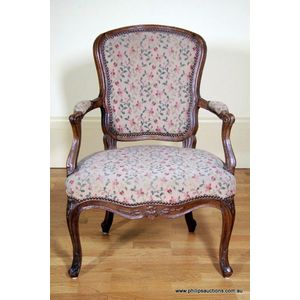Victorian Tub Chairs with Sheraton Revival Splats
You must be a subscriber, and be logged in to view price and dealer details.
Subscribe Now to view actual auction price for this item
When you subscribe, you have the option of setting the currency in which to display prices to $Au, $US, $NZ or Stg.
- Turning - Any part of a piece of furniture that has been turned and shaped with chisels on a lathe. Turned sections include legs, columns, feet, finials, pedestals, stretchers, spindles etc. There have been many varieties and fashions over the centuries: baluster, melon, barley-sugar, bobbin, cotton-reel, rope-twist, and so on. Split turning implies a turned section that has been cut in half lengthwise and applied to a cabinet front as a false decorative support.
- Spindles - Short turned pieces, used as stretchers or back supports mainly in cottage chairs, couches and day beds. Turned shelf supports and the railings used in the backs and arms of day beds during the late 19th century are also referred to as spindles. Until the coming of the industrial age, spindles, like all turned pieces, were made by hand, and should show some slight variation. With the introduction of the factory lathe, spindles and turned legs became quite uniform and standard.
- Circa - A Latin term meaning 'about', often used in the antique trade to give an approximate date for the piece, usually considered to be five years on either side of the circa year. Thus, circa 1900 means the piece was made about 1900, probably between 1895 and 1905. The expression is sometimes abbreviated to c.1900.
- Victorian Period - The Victorian period of furniture and decorative arts design covers the reign of Queen Victoria from 1837 to 1901. There was not one dominant style of furniture in the Victorian period. Designers used and modified many historical styles such as Gothic, Tudor, Elizabethan, English Rococo, Neoclassical and others, although use of some styles, such as English Rococo and Gothic tended to dominate the furniture manufacture of the period.
The Victorian period was preceded by the Regency and William IV periods, and followed by the Edwardian period, named for Edward VII (1841 ? 1910) who was King of the United Kingdom and the British Dominions and Emperor of India for the brief period from 1901 until his death in 1910. - Jacquard Fabric - Jacquard fabric is woven on a jacquard loom, which allows intricate and complex patterns to be created. The jacquard loom is controlled by a system of punched cards or a computer program that controls the movement of the loom and allows for the creation of complex patterns in the fabric.
Jacquard fabric is known for its elaborate and detailed designs, which can include intricate floral patterns, geometric designs, and other complex motifs. The patterns are woven into the fabric, rather than printed or embroidered, which gives them a unique texture and depth.
Jacquard fabrics can be made from a variety of fibress, including silk, cotton, wool, and synthetic materials. They are often used for upholstery, drapery, and other decorative applications, as well as for clothing such as dresses, suits, and jackets. - Thomas Sheraton - Thomas Sheraton (1751-1806) was born in Stockton on Tees in the north of England. He was apprenticed to a local cabinetmaker and after working as a cabinetmaker, Sheraton moved to London about 1790. Although he described himself as a cabinet-maker, like Chippendale, no definite piece of furniture can be traced to him as maker. Nevertheless, he was immensely influential and in 1791-4 published his four volume book 'The Cabinet-Maker and Upholsterer's Drawing Book'. The books were used as source of design by the furniture-making trade , who often simplified or modified the designs to suit their own preferences. Sheraton furniture is marked by restraint and sophistication, elegance and discretion, though he also found time to invent fanciful combination furniture.
This item has been included into following indexes:
-
chairs, singles / pairs / threes, style or period
- Sheraton syle 80
- tub 112
- Victorian, other styles 1,179
Visually similar items

A Louis XV-style salon suite, comprising a canape and two fauteuils, with shaped frames and floral cresting, overpainted in olive green with gold highlights and upholstered in a beige-toned floral cut velvet, on cabriole legs. Sofa height 102 cm. Length 13

A late Victorian mahogany upholstered armchair, late 19th century, the button back chair with a showframe and a gently arched crest with small relief button rosettes, padded arms and turned supports, a generous stuffover seat and raised on turned legs term

A pair of oak Louis XIII style armchairs, circa 1940, upholstered in multicoloured velvet brocade, with a high arched padded and studded back, curved arms, the cushioned seat similarly upholstered, terminating in square and knopped legs with turned H form

A Louis XV-style walnut fauteuil, 19th century, possibly earlier, the moulded frame decorated with carved decorative details, upholstered in close-nailed floral fabric. Height 88 cm. Width 61 cm. Depth 64 cm.
